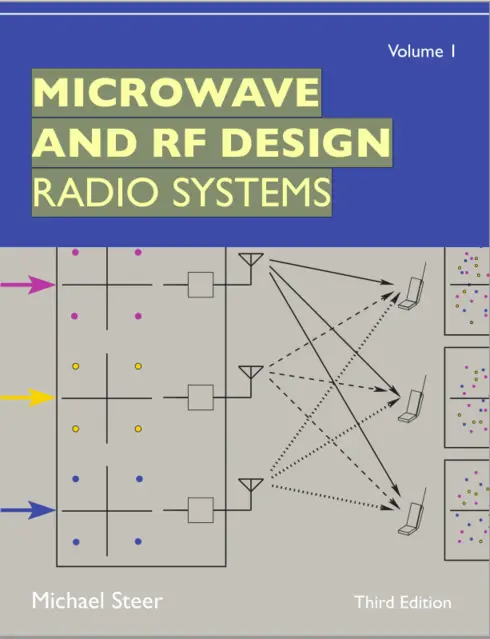
Microwave and RF Design: Radio Systems
![]()
![]()
![]()
![]()
![]()
Michael Steer, NC State
Copyright Year:
Publisher: North Carolina State University Libraries
Language: English
Formats Available
Conditions of Use
![]() Attribution-NonCommercial
Attribution-NonCommercial
CC BY-NC
Reviews
Reviewed by Yang Zhao, Assistant Professor, Taylor University on 6/7/22
This textbook introduces the fundamental concepts of radio systems. It covers the topics of radio frequency systems, modulation, transmitters and receivers, and antennas and radio frequency links. The content prepares the students for further... read more
![]()
![]()
![]()
![]()
![]()
Reviewed by Yang Zhao, Assistant Professor, Taylor University on 6/7/22
Comprehensiveness
This textbook introduces the fundamental concepts of radio systems. It covers the topics of radio frequency systems, modulation, transmitters and receivers, and antennas and radio frequency links. The content prepares the students for further study on microwave and radio frequency design. This textbook is the first volume in a five-volume series on radio systems. The series could help in a junior or senior course on radio systems, antenna systems, or applied electromagnetic systems.
Content Accuracy
This textbook presents the concepts, definitions, symbols, and examples of radio systems accurately in the text, equations, graphics, and tables. The references are listed in each chapter to help the readers explore more information.
Relevance/Longevity
This textbook is up-to-date, as it is the third edition (2019). It discusses the most recent technology in radio systems like the 5th and 6th generations of radio systems. The theories in this textbook are fundamental, and they need to be covered now (2022) and in the future.
Clarity
This textbook explains the theories and applications of radio systems clearly in the text, equations, and graphics. Tables help to organize the information and compare the features of each item. The detailed solutions show how to solve the example problems.
Consistency
The symbols, terms, and concepts are consistent throughout the textbook. The text explains the meanings of the parameters in the equations and graphics. The terminologies in this book are identical to other textbooks and industry.
Modularity
This textbook contains five chapters. Each chapter focuses on one or two topics. Chapter one introduces the physical laws of electromagnetism, which is relatively short. Chapters two, three, four, and five have almost the same length. The instructors may divide up the content to design a course conveniently.
Organization/Structure/Flow
This textbook is well organized. It introduces electromagnetism in chapter one and the mathematics of random processes in the appendix for background information. It discusses the theories such as modulation, transmitters/receivers, and antennas/radio frequency links in two, three, and four. The exercises problems with the selected answers are in each chapter.
Interface
This textbook has a friendly interface. There is space on the side of the text for the readers to write notes. The graphics are clear in readable fonts and detailed captions. The curves in the plots are labeled to show their meaning. The text is compact to put the relative information together for readers.
Grammatical Errors
Grammatical errors are undiscovered.
Cultural Relevance
There is no cultural relevance issue, as this textbook focuses on the theories and applications of radio systems.
CommentsThe example problems and their solutions help the students understand the theories. The exercise problems encourage the students to review the content. The case study gives the students an idea of the practical problem in the industry. It would be better to provide some code (MATLAB probably) so that the students may regenerate some of the plots in the case study for better understanding.
Table of Contents
- 1 Introduction to RF and Microwave Systems
- 2 Modulation
- 3 Transmitters and Receivers
- 4 Antennas and the RF Link
- 5 RF Systems
About the Book
Microwave and RF Design: Radio Systems is a circuits- and systems-oriented approach to modern microwave and RF systems. Sufficient details at the circuits and sub-system levels are provided to understand how modern radios are implemented. Design is emphasized throughout. The evolution of radio from what is now known as 0G, for early radio, through to 6G, for sixth generation cellular radio, is used to present modern microwave and RF engineering concepts. Two key themes unify the text: 1) how system-level decisions affect component, circuit and subsystem design; and 2) how the capabilities of technologies, components, and subsystems impact system design. This book is suitable as both an undergraduate and graduate textbook, as well as a career-long reference book.
About the Contributors
Author
Michael Steer is the Lampe Distinguished Professor of Electrical and Computer Engineering at North Carolina State University. He received his B.E. and Ph.D. degrees in Electrical Engineering from the University of Queensland. He is a Fellow of the IEEE and is a former editor-in-chief of IEEE Transactions on Microwave Theory and Techniques. He has authored more than 500 publications including twelve books. In 2009 he received a US Army Medal, “The Commander’s Award for Public Service.” He received the 2010 Microwave Prize and the 2011 Distinguished Educator Award, both from the IEEE Microwave Theory and Techniques Society.
